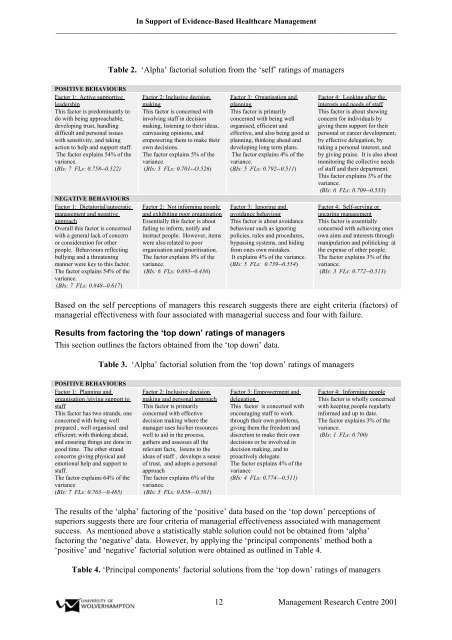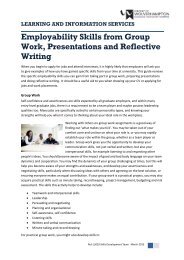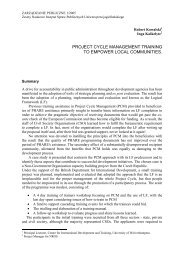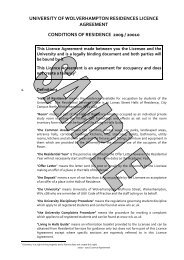In Support of Evidence-Based Healthcare Management: an ...
In Support of Evidence-Based Healthcare Management: an ...
In Support of Evidence-Based Healthcare Management: an ...
- No tags were found...
You also want an ePaper? Increase the reach of your titles
YUMPU automatically turns print PDFs into web optimized ePapers that Google loves.
<strong>In</strong> <strong>Support</strong> <strong>of</strong> <strong>Evidence</strong>-<strong>Based</strong> <strong>Healthcare</strong> <strong>M<strong>an</strong>agement</strong>_________________________________________________________________________________________Table 2. ‘Alpha’ factorial solution from the ‘self’ ratings <strong>of</strong> m<strong>an</strong>agersPOSITIVE BEHAVIOURSFactor 1: Active supportiveleadershipThis factor is predomin<strong>an</strong>tly todo with being approachable,developing trust, h<strong>an</strong>dlingdifficult <strong>an</strong>d personal issueswith sensitivity, <strong>an</strong>d takingaction to help <strong>an</strong>d support staff.The factor explains 54% <strong>of</strong> thevari<strong>an</strong>ce.(BIs: 7 FLs: 0.758--0.522)NEGATIVE BEHAVIOURSFactor 1: Dictatorial/autocraticm<strong>an</strong>agement <strong>an</strong>d negativeapproachOverall this factor is concernedwith a general lack <strong>of</strong> concernor consideration for otherpeople. Behaviours reflectingbullying <strong>an</strong>d a threateningm<strong>an</strong>ner were key to this factor.The factor explains 54% <strong>of</strong> thevari<strong>an</strong>ce.(BIs: 7 FLs: 0.848--0.617)Factor 2: <strong>In</strong>clusive decisionmakingThis factor is concerned withinvolving staff in decisionmaking, listening to their ideas,c<strong>an</strong>vassing opinions, <strong>an</strong>dempowering them to make theirown decisions.The factor explains 5% <strong>of</strong> thevari<strong>an</strong>ce.(BIs: 5 FLs: 0.701--O.526)Factor 2: Not informing people<strong>an</strong>d exhibiting poor org<strong>an</strong>isationEssentially this factor is aboutfailing to inform, notify <strong>an</strong>dinstruct people. However, itemswere also related to poororg<strong>an</strong>isation <strong>an</strong>d prioritisation.The factor explains 8% <strong>of</strong> thevari<strong>an</strong>ce.(BIs: 6 FLs: 0.693--0.436)Factor 3: Org<strong>an</strong>isation <strong>an</strong>dpl<strong>an</strong>ningThis factor is primarilyconcerned with being wellorg<strong>an</strong>ised, efficient <strong>an</strong>deffective, <strong>an</strong>d also being good atpl<strong>an</strong>ning, thinking ahead <strong>an</strong>ddeveloping long term pl<strong>an</strong>s.The factor explains 4% <strong>of</strong> thevari<strong>an</strong>ce.(BIs: 5 FLs: 0.792--0.511)Factor 3: Ignoring <strong>an</strong>davoid<strong>an</strong>ce behaviourThis factor is about avoid<strong>an</strong>cebehaviour such as ignoringpolicies, rules <strong>an</strong>d procedures,bypassing systems, <strong>an</strong>d hidingfrom ones own mistakes.It explains 4% <strong>of</strong> the vari<strong>an</strong>ce.(BIs: 5 FLs: 0.739--0.554)Factor 4: Looking after theinterests <strong>an</strong>d needs <strong>of</strong> staffThis factor is about showingconcern for individuals bygiving them support for theirpersonal or career development;by effective delegation, bytaking a personal interest, <strong>an</strong>dby giving praise. It is also aboutmonitoring the collective needs<strong>of</strong> staff <strong>an</strong>d their department.This factor explains 3% <strong>of</strong> thevari<strong>an</strong>ce.(BIs: 6 FLs: 0.709--0.533)Factor 4: Self-serving oruncaring m<strong>an</strong>agementThis factor is essentiallyconcerned with achieving onesown aims <strong>an</strong>d interests throughm<strong>an</strong>ipulation <strong>an</strong>d politicking atthe expense <strong>of</strong> other people.The factor explains 3% <strong>of</strong> thevari<strong>an</strong>ce.(BIs: 3 FLs: 0.772--0.513)<strong>Based</strong> on the self perceptions <strong>of</strong> m<strong>an</strong>agers this research suggests there are eight criteria (factors) <strong>of</strong>m<strong>an</strong>agerial effectiveness with four associated with m<strong>an</strong>agerial success <strong>an</strong>d four with failure.Results from factoring the ‘top down’ ratings <strong>of</strong> m<strong>an</strong>agersThis section outlines the factors obtained from the ‘top down’ data.Table 3. ‘Alpha’ factorial solution from the ‘top down’ ratings <strong>of</strong> m<strong>an</strong>agersPOSITIVE BEHAVIOURSFactor 1: Pl<strong>an</strong>ning <strong>an</strong>dorg<strong>an</strong>isation /giving support tostaffThis factor has two str<strong>an</strong>ds, oneconcerned with being wellprepared , well org<strong>an</strong>ised <strong>an</strong>defficient; with thinking ahead,<strong>an</strong>d ensuring things are done ingood time. The other str<strong>an</strong>dconcerns giving physical <strong>an</strong>demotional help <strong>an</strong>d support tostaff.The factor explains 64% <strong>of</strong> thevari<strong>an</strong>ce(BIs: 7 FLs: 0.763—0.485)Factor 2: <strong>In</strong>clusive decisionmaking <strong>an</strong>d personal approachThis factor is primarilyconcerned with effectivedecision making where them<strong>an</strong>ager uses his/her resourceswell to aid in the process,gathers <strong>an</strong>d assesses all therelev<strong>an</strong>t facts, listens to theideas <strong>of</strong> staff , develops a sense<strong>of</strong> trust, <strong>an</strong>d adopts a personalapproachThe factor explains 6% <strong>of</strong> thevari<strong>an</strong>ce.(BIs: 5 FLs: 0.858—0.581)Factor 3: Empowerment <strong>an</strong>ddelegationThis factor is concerned withencouraging staff to workthrough their own problems,giving them the freedom <strong>an</strong>ddiscretion to make their owndecisions or be involved indecision making, <strong>an</strong>d toproactively delegate.The factor explains 4% <strong>of</strong> thevari<strong>an</strong>ce(BIs: 4 FLs: 0.774—0.511)Factor 4: <strong>In</strong>forming peopleThis factor is wholly concernedwith keeping people regularlyinformed <strong>an</strong>d up to date.The factor explains 3% <strong>of</strong> thevari<strong>an</strong>ce.(BIs: 1 FLs: 0.700)The results <strong>of</strong> the ‘alpha’ factoring <strong>of</strong> the ‘positive’ data based on the ‘top down’ perceptions <strong>of</strong>superiors suggests there are four criteria <strong>of</strong> m<strong>an</strong>agerial effectiveness associated with m<strong>an</strong>agementsuccess. As mentioned above a statistically stable solution could not be obtained from ‘alpha’factoring the ‘negative’ data. However, by applying the ‘principal components’ method both a‘positive’ <strong>an</strong>d ‘negative’ factorial solution were obtained as outlined in Table 4.Table 4. ‘Principal components’ factorial solutions from the ‘top down’ ratings <strong>of</strong> m<strong>an</strong>agers12 <strong>M<strong>an</strong>agement</strong> Research Centre 2001
















